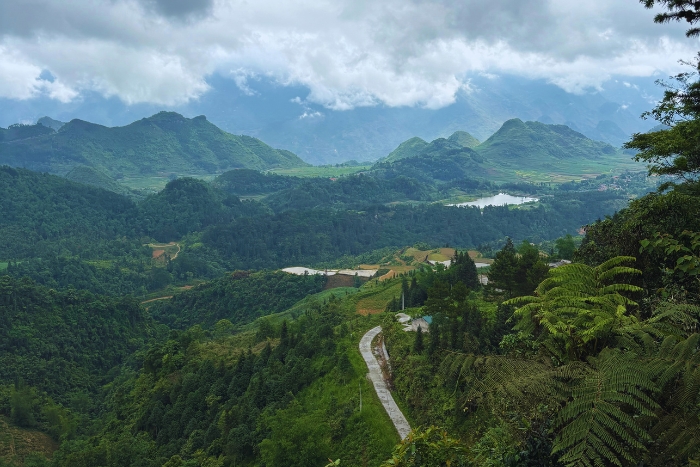1. Visit Dong Van karst plateau
- Address: Xà Phìn, Đồng Văn district, Hà Giang province, Việt Nam
- Google Map: https://goo.gl/maps/8aUzaMocsLcJ47iu7
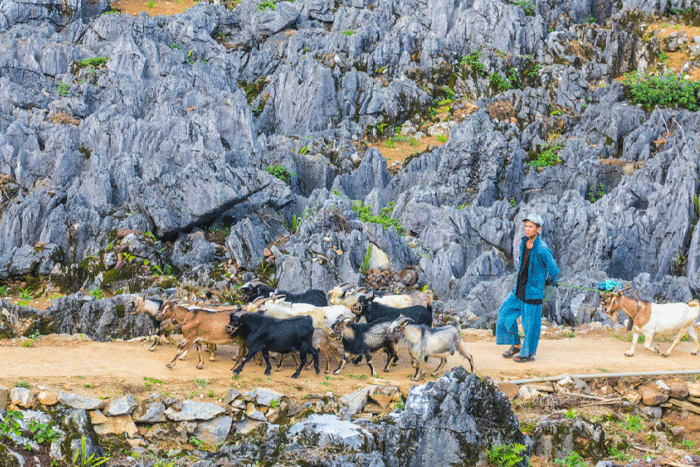
Dong Van Karst Plateau, located approximately 300 km from Hanoi in Ha Giang province, is a popular tourist destination renowned for its captivating beauty. Recognized as Vietnam's first geopark by UNESCO in 2010, this plateau spans across four districts, offering a vast area of exploration. With its average elevation of 1000 - 1600m above sea level, Dong Van Karst Plateau showcases a harmonious blend of natural wonders and human heritage. From the breathtaking Ma Pi Leng Pass to the ancient rock formations of Lung Cu Flagpole, each corner of this plateau unveils a fascinating story. This plateau is a place of ever-changing beauty. Each season brings a new color, with white plum and ban flowers in January and February, and vibrant red rice flowers in March. Ha Giang province comes alive with nature's vivid palette, offering a beautiful sight for visitors to enjoy. This place promises visitors an unforgettable journey of discovery and connects people with the magical nature.
2. Best things to do in Ha Giang? Visit Pao’s house
- Address: Lũng Cẩm, Sủng Là valley, Đồng Văn district, Hà Giang province, Việt Nam
- Entrance fee: 10,000 VND/person
- Google Map: https://goo.gl/maps/izmiB7rrfNKRw3g68
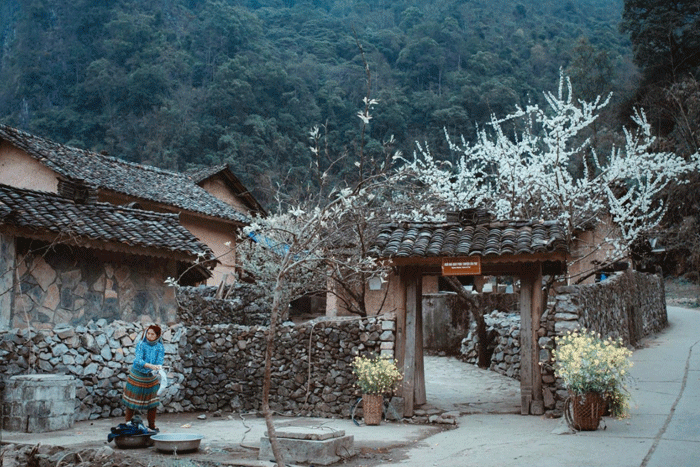
Pao's House is a popular destination that draws many tourists to Ha Giang, Vietnam. It gained fame as the filming location for the award-winning movie "The Story of Pao" directed by Ngo Quang Hai. Pao is the name of a H'Mong girl - the main character in the movie. After the film was released to the audience, this place attracted a lot of tourists, who came here to check in at filming locations and discover the simple beauty of the house. When visiting, it's important to respect local customs by avoiding wearing white, which symbolizes unfortunate events. You should also ask the landlord's permission before entering and especially not touching household items. Pao's House provides an insightful glimpse into the local way of life and offers a memorable cultural experience for tourists.
3. Dong Van old quarter
- Address: Đồng Văn district, Hà Giang province, Việt Nam
- Entrance fee: 50,000 VND/ adult and 20,000 VND/ child
- Google Map: https://goo.gl/maps/FY5ZJBtpo5XctmcC8
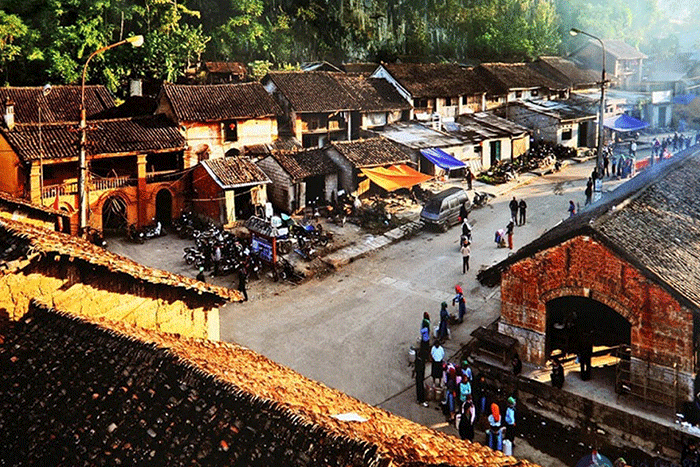
Dong Van Old Town is located in Dong Van town, Ha Giang province, about 320 km from Hanoi. Dong Van Old Town is always crowded every day, especially during the festival and Ha Giang buckwheat flower season from October to December. With only 40 neighboring households nestled beneath rocky cliffs, Dong Van Old Town exudes a unique charm. Visitors can delve into the exploration of ancient architecture, immerse themselves in the vibrant traditional markets, and savor the timeless ambiance of local cafes. A must-visit site is "Quán," a house that has preserved its ancient beauty and serves as an ideal check-in location. Dong Van Old Town unveils different hues throughout the day, from the brilliant yellow tones harmonizing with the old houses in the morning, to the gentle sunset glow in the afternoon, and the vibrant colors of shimmering lights after dark. All create a colorful picture.
4. Go to Meo Vac market Ha Giang
- Address: Mèo Vạc town, Mèo Vạc district, Hà Giang province, Việt Nam
- Google Map: https://goo.gl/maps/17G12EQVFmMtw32p9
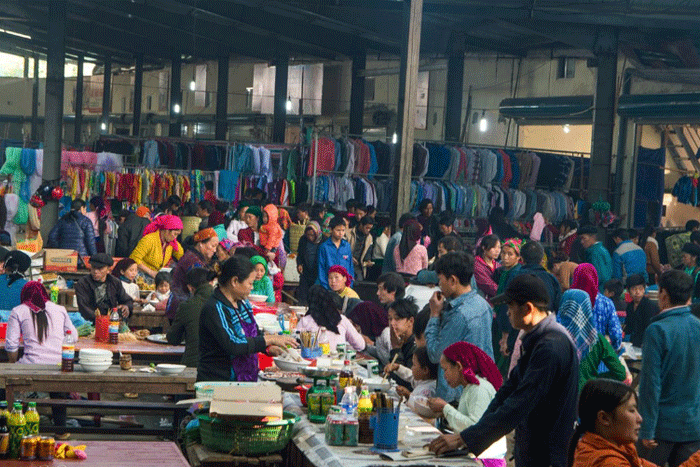
5. Conquer Ma Pi Leng Pass
- Address: Pải Lủng, Mèo Vạc district, Hà Giang province, Việt Nam
- Google Map: https://goo.gl/maps/vTeuQD7kV7SgJobn8
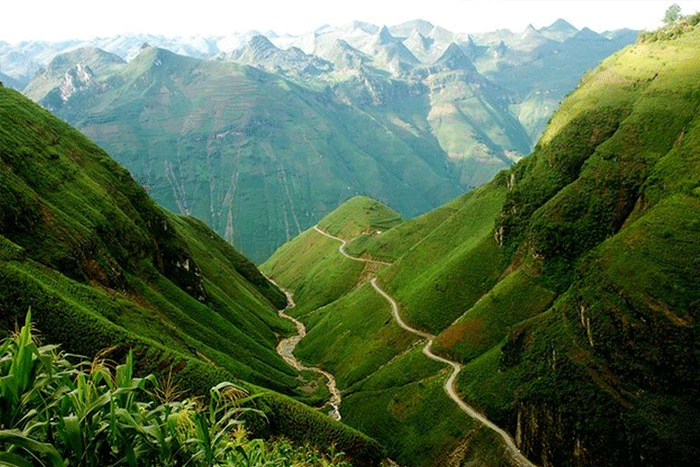
6. Come to Hoang Su Phi to see rice terrace
- Address: Hà Giang province, Việt Nam
- Google Map: https://goo.gl/maps/bw12PFjSTjUruDXL8
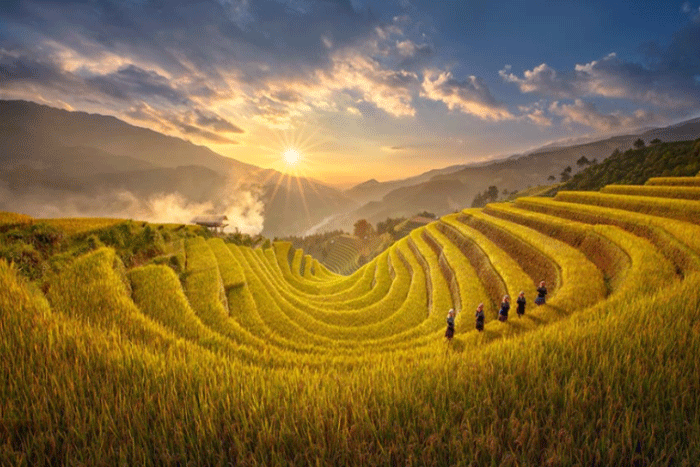
Hoang Su Phi is a border district located in the west of Ha Giang province. Located approximately 400 kilometers from Hanoi and over 100 kilometers from the center of Ha Giang city, reaching the enchanting tourist sites in Hoang Su Phi involves traversing rugged passes and challenging roads. However, this is also a feature when discovering Hoang Su Phi in particular or Ha Giang in general. Overcoming the difficulties on the way, visitors will admire the majestic and poetic beauty of the mountains. The terraced fields here have been recognized as a national monument, attracting many tourists to explore. Hoang Su Phi mesmerizes visitors throughout the year, with each season showcasing its own unique beauty that epitomizes the allure of Ha Giang.
7. Lung Cu flagpole
- Address: Lũng Cú, Đồng Văn district, Hà Giang province, Việt Nam
- Entrance fee: 25,000 VND/ adult and free for children under 1.3m tall
- Tram fare: 15,000 VND/ pax and free for children under 5 years old
- Google Map: https://goo.gl/maps/YbB466Eft48gLoB39
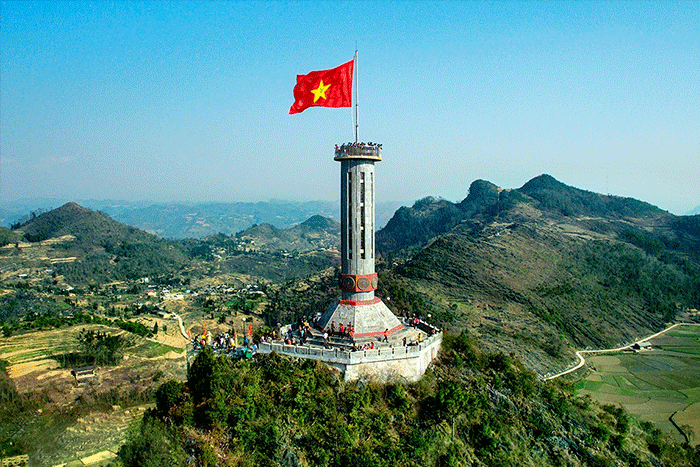
8. Nho Que river
- Address: Hà Giang province, Việt Nam
- Ticket for boat: from 100,000 VND/ pax to 120,000 VND/ pax
- Google Map: https://goo.gl/maps/rTd2FLTaU3JfQTQJ7
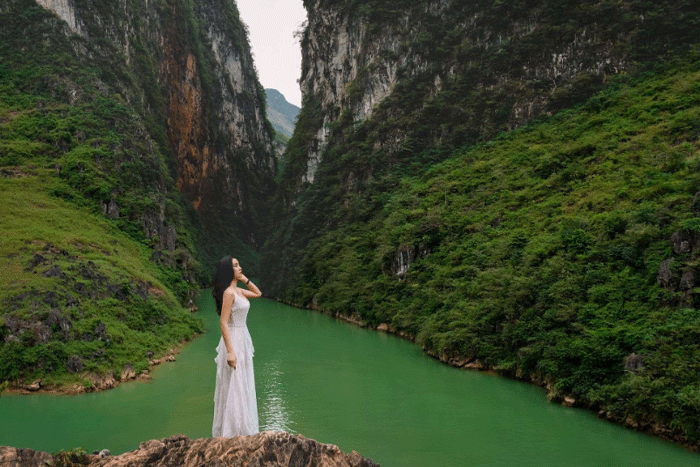
Nho Que river, located at the base of Ma Pi Leng Pass, is a well-known destination among tourists visiting Ha Giang. Originating in the mountains of Nghiem Son in Yunnan, China, this river gracefully flows in a northwest to southeast direction into Vietnam. Nho Que River has a length of 192 km and flows through many layers of rock, making the river like a winding green silk. Nestled between towering cliffs and a seemingly bottomless abyss, Ma Pi Leng Pass offers a vantage point to fully appreciate the beauty of the river. In 2009, the Ministry of Culture, Sports and Tourism classified this river as a Vietnam Scenic Landscape Relic. If you love nature and adventure, this is one of the places you should visit once in your life.
9. Quan Ba twin mountains
- Address: Quản Bạ, Tam Sơn town, Hà Giang province, Việt Nam
- Google Map: https://goo.gl/maps/qBfJHjAJ1nBs5Djt6
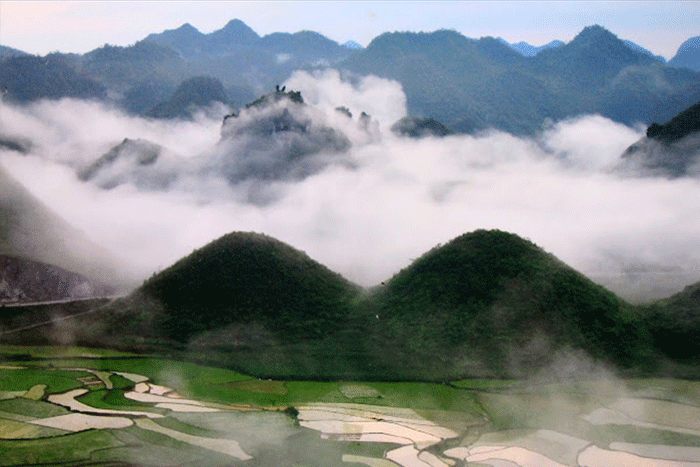
Besides the legendary Ma Pi Leng pass and the majestic Dong Van rock plateau, Quan Ba Ha Giang is also an impressive destination, attracting many check-ins from tourists. This well-known stopover is an essential part of the journey to uncover the splendor of Ha Giang's landscapes. Quan Ba Twin Mountain, also referred to as Double Mountain or Co Tien Mountain, holds a remarkable history dating back approximately 1.6 to 2 million years. Its name originates from the striking similarity between the two mountains, standing side by side in perfect parallel alignment. Visitors coming here can both admire the beauty of nature and discover the fascinating story of the legend of the Twin Mountain.
10. Tham Ma Slope
- Address: Đồng Văn, Hà Giang province, Việt Nam
- Google Map: https://goo.gl/maps/RrFWTbqxmVzAhVWh7
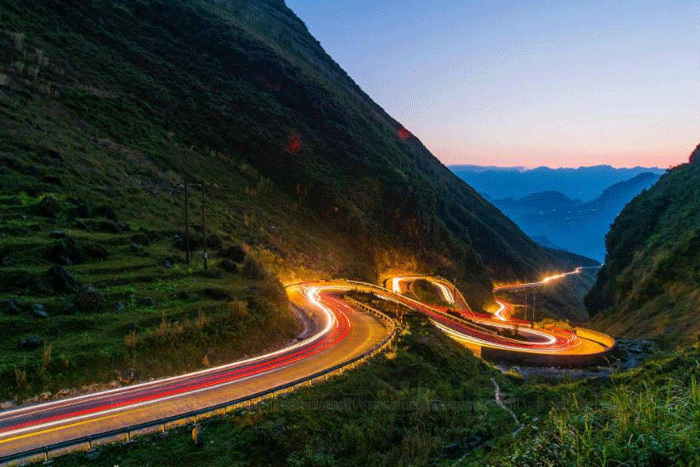
Located right on National Highway 4C, Tham Ma slope is the most dangerous zigzag pass in the North connecting Ha Giang city and Meo Vac district. This is a 5km long slope, connecting the road from Yen Minh town to Pho Cao. Visitors will be able to challenge themselves on the slope full of bends, conquer the difficulty of the slope and discover the interesting geological heritages of the Dong Van Stone Plateau Global Geopark. If you go there in the evening, you will be rewarded with a breathtaking view of the splendid sunset. Prepare yourself with the right outfits to take memorable photos here!
11. Discover the mansion of Vuong family in Ha Giang
- Address: Xà Phìn, Đồng Văn district, Hà Giang province, Việt Nam
- Entrance fee: 20,000 VND/ pax
- Opening hours: 7:00 a.m - 5:00 p.m
- Google Map: https://goo.gl/maps/9JVVzrBTtQo7D2m48
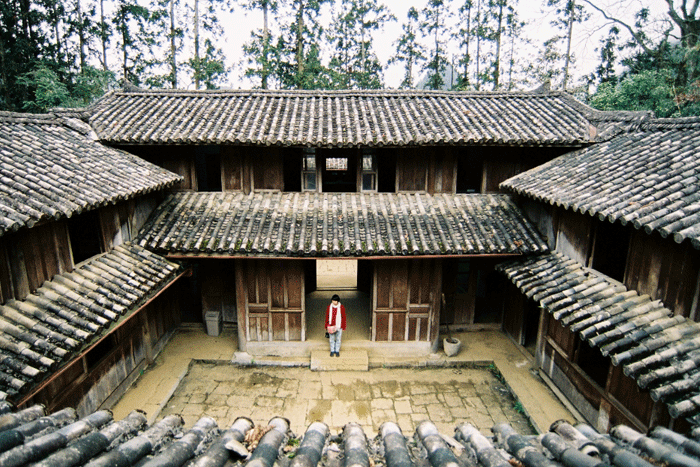
The mansion of Vuong family has an area of nearly 3,000m2, located in the middle of Sa Phin valley, Dong Van district, Ha Giang. Combining elements of Qing Dynasty citadels, Mong patterns, and French colonial architecture, this mansion impresses visitors to the Ha Giang stone plateau. According to many recorded documents, the mansion of the Vuong family was built in 1919, it holds historical significance related to Mong leaders Vuong Chinh Duc and Vuong Chi Sinh, who governed the Quan Ba, Yen Minh, Dong Van, and Meo Vac districts. The palace resembles a tortoise shell amidst a cloud-covered mountain valley, surrounded by Mong stone walls. It stands as a cherished symbol of culture, history, and solidarity in Vietnam's northernmost region, preserving the Mong people's heritage on the Stone Plateau.
12. See buckwheat flower fields in Sung La valley
- Address: Sủng Là, Đồng Văn district, Hà Giang province, Việt Nam
- Google Map: https://goo.gl/maps/9wLPMnfuUqrVQJuZ6
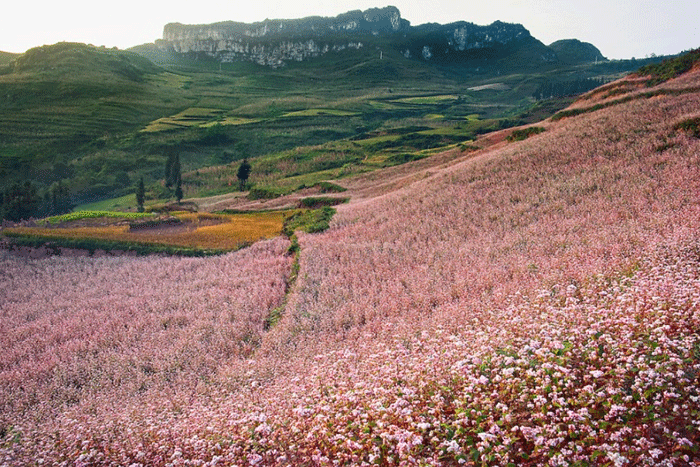
Situated along Highway 4C, approximately 20 km from Dong Van district and 127 km from Ha Giang city, lies Sung La Valley. Translated as "oasis” in the local ethnic language, Sung La Valley is renowned for its picturesque buckwheat flower fields. Famous for its blooming flower gardens, Sung Valley is often called a brilliant flower in the middle of the rocky plateau, always attracting visitors by its very idyllic and rustic beauty. During springtime, the valley comes alive with vibrant blooms, dispelling the cold and barren ambiance of the rocks and plateaus. Here, you can rediscover tranquility as you observe children adorned with colorful scarves playing in the fields.
13. Quan Ba heaven gate
- Address: Quản Bạ, Hà Giang province, Việt Nam
- Google Map: https://goo.gl/maps/svfqZhGpiYznbEfJ9
